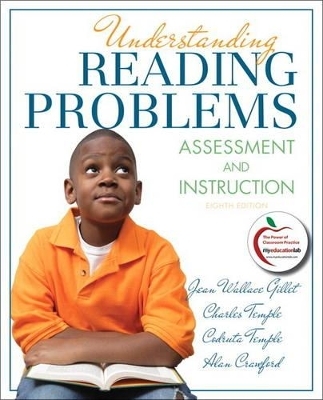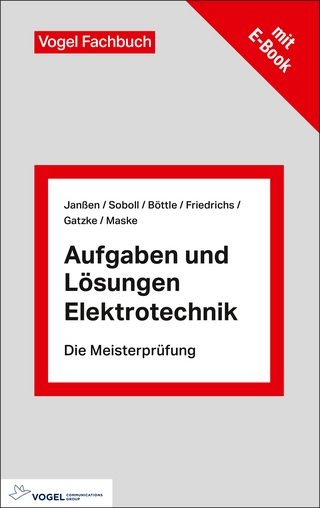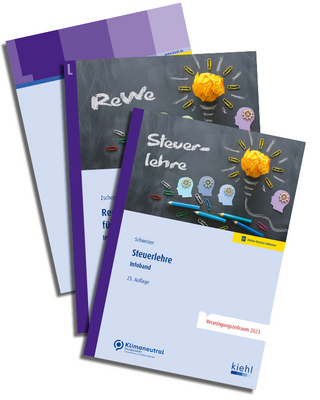
Understanding Reading Problems
Pearson
978-0-13-300753-4 (ISBN)
- Titel erscheint in neuer Auflage
- Artikel merken
Packages
Access codes for Pearson's MyLab & Mastering products may not be included when purchasing or renting from companies other than Pearson; check with the seller before completing your purchase.
Used or rental books
If you rent or purchase a used book with an access code, the access code may have been redeemed previously and you may have to purchase a new access code.
Access codes
Access codes that are purchased from sellers other than Pearson carry a higher risk of being either the wrong ISBN or a previously redeemed code. Check with the seller prior to purchase.
--The Eighth Edition of Understanding Reading Problems is a thorough updating of a market-leading book written by highly popular authors Jean Wallace Gillet, Charles Temple, Codruta Temple, and Alan Crawford. Featuring classroom-based, teacher-driven approaches to effective reading assessment and remediation, this new edition covers reading processes, their assessment and their corrective instruction and includes thorough treatments of reading and writing at every stage of development. The Eighth Edition is organized by developmental levels, with explanations of reading issues at each level, approaches to assessment, and teaching methods delivered at the point of need.
Jean Gillet has been an elementary reading specialist in central Virginia. She has also served as a classroom teacher, staff development specialist, and university educator. Her professional interests include the diagnosis and correction of reading difficulties, children’s developmental spelling, and children’s writing. Jean’s extensive published work includes topics such as including contributing to classroom instructional materials on writing and spelling. The coauthor of several textbooks for teachers on language arts, reading, writing, and spelling, she received her doctorate from the University of Virginia. Charles Temple teaches courses in literacy and peace studies at Hobart and William Smith Colleges in Geneva, New York. Dr. Temple studied with the late Edmund Henderson at the University of Virginia, where he explored reading instruction, reading disabilities, invented spelling, and what was to become emergent literacy. His published books cover such topics as emergent literacy, writing instruction, language arts, diagnosis and remediation of reading disabilities, and children’s literature. He is a director of Critical Thinking International, Inc., a non-profit corporation that develops materials and fields mid-career professionals for teacher training around the world. Codruta Temple taught English as a foreign language and was principal of a bilingual lyceum (high school) in Romania. She taught French as a Fulbright Scholar in California before moving permanently to the United States, where she earned a PhD. in English Education and linguistics at Syracuse University. Professor Temple now divides her time between teaching ESL methods and linguistics at New York State University College at Cortland and at Hobart and William Smith Colleges in Geneva. Alan Crawford is Emeritus Professor of Education at California State University, Los Angeles. A Past President of the California Reading Association, he has done extensive teaching, consulting, and writing on teaching reading in the elementary school, especially for English language learners. Alan has written curriculum for teaching reading in Spanish and serves on the Editorial Review Board of Lectura y Vida. He served as IRA’s representative to UNESCO for many years and was a Senior Literacy Specialist at UNESCO in Paris during International Literacy Year (1989-90). He is a director of Critical Thinking International and frequently presents workshops on a volunteer basis for international development projects in Latin America, Europe, Asia, and Africa
Contents
Preface
chapter 1 Reading and Its Assessment
Framing the Issues
Reading Assessment
Different Assessments for Different Phases of Instruction
Approaches to Assessment
The Process of Learning to Read at Different Stages
Emergent Literacy
Beginning Reading
Fledgling Reading
Developing Reading
Mature Reading
Differentiated Instruction
Response to Intervention
Summary References
CHAPTER 2 Response To Intervention (RTI) and Struggling Readers
From a Discrepancy Model to Response to Intervention: The Origins of RTI
Individuals with Disabilities Education Act of 1997(IDEA)
Individuals with Disabilities Education Improvement Act of 2004 (IDEIA)
Response to Intervention (RTI)
No Child Left Behind (NCLB) and Reading First
Characteristics of RTI: What It Is, What It Isn’t
Recommended Principles of RTI from the International Reading Association
The Multi-Tiered Structure of RTI
Tier One: General Education Program
Tier Two: Small-Group Intervention
Tier Three: Intensive Intervention
Approaches and Models for Implementing RTI
Interactive Strategies Approach (ISA)
Comprehensive Intervention Model (CIM)
The Role of Assessment in RTI
Curriculum-Based Measurement (CBM) (benchmark assessment)
Diagnostic Assessment
Progress Monitoring
False Positives
Evidence-Based Literacy Programs
Members of the RTI Team and Their Roles
RTI in Middle Schools and High Schools
Middle Schools
High Schools
Implications of RTI for Special Education
English Language Learners and RTI
RTI and the Gifted
The Role of Technology in RTI
Summary
Reference
CHAPTER 3 Assessing and Teaching Emergent Readers
Understanding Emergent Literacy
Aspects of Emergent Literacy
Assessing Emerging Readers
Assessing Print Concepts
Alphabet Knowledge
Assessing Alphabet Knowledge
The Concept of Word
Assessing the Concept of Word
Phonological Awareness
The Importance of Phonological Awareness
Assessing Phonological Awareness
Distinguishing Rhyming Words from Non-rhyming Words
Producing Rhymes
Phoneme Isolation
Phoneme Comparison
Phoneme Addition
Phoneme Subtraction
Phoneme Segmentation
Assessing Phonemic Awareness by Means of Invented Spelling
Oral Language Development
Vocabulary
Assessing Vocabulary
Syntax, or Grammar
Decontextualized Language
Assessing for Knowledge of Decontextualized Language
Narrative Comprehension
Picture Walk
Story Retelling
Prompted Comprehension
Widely Distributed Tests of Emergent Literacy
Teaching for Emergent Literacy
Teaching Print Orientation Concepts
Teaching the Alphabet
Alphabet Books
Letter-Matching Games
Sounds and Letters
Teaching the Concept of Word
The Voice-Pointing Procedure
Cut-Apart Words
Dictated Experience Accounts
Morning Message
Teaching to Build Phonological Awareness
At the Syllable Level
At the Onset-and-Rime Level
At the Phoneme Level
Teaching for Many Things at Once
Reading Storybooks
Reading Many Books, Repeatedly
Reading Expressively
Shared Reading
Conducting a Shared Reading Lesson
Dialogic Reading
Teaching to Nurture Vocabulary Development
Teaching Decontextualized Language
Storytelling for Comprehension
Learning Stories to Tell
Summary
References
CHAPTER 4: Assessing and Teaching Beginning and Fledgling Readers and Writers
Components of Beginning and Fledgling Reading
Word Recognition
Sight Words
High Frequency Sight Words
Sight Words as Learned Words
Word Recognition by Decoding
Comprehension, the Ability to Derive Meaning from Text
Reading Fluency
Assessing Beginning and Fledgling Readers
Running Records
Running Records to Document Progress
Running Records and Text Difficulty
Further Assessments of Beginning and Fledgling Readers
Assessing Knowledge of Sight Words
Assessing Word Knowledge through Invented Spelling: The Monster Test
Applying the Results of The Monster Test
Assessing Word Knowledge By Means of Novel Words: Demtup
Instruction for Beginning and Fledgling Readers
Tutoring Lesson
Writing
Shared writing with individual children
Interactive Writing With a Small Group
Attention to Handwriting
Word Study
Sound Boards
Making and Breaking Words
Push It Say It
Teaching High Frequency Words
Reading aloud
The Language Experience Approach
Planning and Record Keeping
Summary
References
CHAPTER 5: Informal Assessments of Reading
Informal Reading Inventories
Selecting an Informal Reading Inventory
Quality of Passages.
Types of Text.
Quality of Questions.
Format and Instructions.
Administering an Informal Reading Inventory
Where to Start
Starting with Word Lists.
Starting with Passages.
Where to Stop
Step-by-Step Administration
Reinspection and Comprehension
Retelling and Comprehension
Marking Oral Reading Miscues
Assessing Listening Comprehension
Assessing Recognition of Words in Isolation
Scoring an Informal Reading Inventory
Levels of Reading Ability
The Independent Level
The Instructional Level
The Frustration Level
The Listening Level
The Usefulness of Reading Levels
Oral Reading Accuracy
Reading Fluency
Reading and Listening Comprehension
Scoring the Word Recognition Inventory
Keeping Track of Scores
Interpreting an Informal Reading Inventory
Establishing Reading and Listening Levels
Qualitative Analysis of Oral Reading Miscues
Comparing Miscues.
Scoring Miscue Acceptability.
What Makes a Miscue Acceptable?
Dialects and Miscues.
What about Names?
Analyzing Reading Comprehension
Comprehension Skill Patterns
Patterns in Listening Comprehension
Analyzing Word Recognition in Isolation
Observations of Reading Behaviors and Strategies
Observing Readers
Physical Behaviors
Cognitive Behaviors
Reading Strategies Observed
Recording Observations
Monitoring Types and Difficulty of Texts Read
Guided Reading Levels
Readability Estimates
The Fry Readability Chart
Lexiles
Cloze Procedures
Constructing a Cloze Passage
Administering a Cloze Passage
Scoring and Interpreting a Cloze
Maze Tests
Student Portfolios
Showcasing Achievement
Documenting Progress
Demonstrating Effort
Fostering Self-Evaluation and Reflection
Kinds of Portfolios
Organizing a Portfolio Program
What Goes into a Portfolio?
Primary Grades
Middle and Upper Grades
Evaluating Portfolios
Teaching Self-Evaluation
Teaching Goal Setting
Teacher Evaluations
Parent Evaluations
Portfolio Conferences
Teacher-Student Conferences
Peer Conferences
Parent Conferences
Measuring Attitudes and Interest in Reading
Summary
References
CHAPTER 6: Teaching Developing Readers
Phonics And Word Knowledge For Developing Readers
Word Knowledge At Different Levels
Logographic Reading
Transitional Alphabetic Reading
Alphabetic Reading
Orthographic Reading
Derivational Reading
Teaching Phonics
Word Study At More Advanced Levels
Guiding Word Study
Teaching Words With Shared Phonogram Patterns
Teaching Words With Grammatical Affixes And Derivational Affixes
Teaching Homophones And Homographs
Developing Sight Vocabulary
Dictated Stories and Language Experience
Support Reading: Echo Reading and Choral Reading
Developing Word Analysis Strategies
Using Context
Approaching Word Attack Strategically
Assessing Reading Fluency
Developing Reading Fluency
Modeling Fluent Oral Reading
Providing Oral Support For Reading
Providing Practice In Oral Reading
Repeated Reading For Fluency
Predictable Books, “Easy Readers,” And Other Easy Reading Fare
Developing Readers’ Vocabulary
Levels of Vocabulary Knowledge
Dissecting Children’s Vocabulary
Approaches to Teaching Vocabulary
Teaching the Use of Context Clues to Vocabulary
Developing Reading Comprehension
For the Phase of Anticipation
For the Phase of Building Knowledge
For the Phase of Consolidation
Developing Listening Comprehension
Time Spent Reading
Summary
References
CHAPTER 7: Assessing and Teaching Middle and Secondary School Readers and Writers
The Reading and Writing Issues of Older Students
Why Should We Be Concerned About Older Students’ Reading and Writing Ability?
Responding to the Needs of Readers and Writers in Middle and Secondary Grades
A Range of Responses to Older Students’ Reading and Writing Needs.
Reading Strategies for Use Across the Curriculum
Strategies for the Anticipation Phase
Advance Organizers
The Anticipation Guide
Group Brainstorming
Paired Brainstorming
Terms In Advance
Think/Pair/Share
Free Writing
Semantic Map
K now/Want to Know/Learn.
Strategies for the Building Knowledge Phase
The I.N.S.E.R.T. Model
Text Coding
Study Guides
Dual-Entry Diaries
Cooperative Learning: Jigsaw II
Strategies for the Reflection Phase
The Discussion Web
Academic Controversy
Providing Close Support for Students’ Reading Development
Organizing Focused Strategic and Intensive Instruction
Assessing Readers for Focused Instruction
Planning Lessons for Disabled Readers
Teaching Strategies to Build Reading Competence
Thinking Aloud
ReQuest Procedure
Visualizing
Questioning the Author
Reading and Questioning
Audio Books
Introducing and Focusing Attention on New Vocabulary
Word Conversations
Vocab-o-gram
Webbed Questions
The Frayer Model
Helping Older Students Write
Eleven Elements of Effective Adolescent Writing Instruction
Teaching Writing Strategies and Teaching the Writing Process Approach.
Rehearsing
Drafting
Revising
Editing or Proofreading
Publishing
Focused Lessons
Having Goals for Writing
Keyboarding Skill
Writing For Inquiry
Ten-Minute Essays and Other Free Writes
The Five-Minute Essay
Three-Part Diaries
The I-Search Paper
Motivational and Emotional Issues of Adolescent Students with Reading Problems
Guiding Principles and Theories
Establishing Trust
Providing Literate Role Models
Reducing the Feeling of Learned Helplessness or Passive Failure
Legitimizing Personal Knowledge and Experiences
Developing a Learning Environment
Summary
References
CHAPTER 8: Assessing Spelling and Writing
Monitoring Spelling Progress and Problems
Developmental Spelling Stages
Early Emergent Stage
Later Emergent Stage
Letter-Name Stage
Within-Word Pattern Stage
Syllables and Affixes Stage
Derivational Constancy Stage
Assessing Spelling Progress
The Word Knowledge Inventory
Developmental Spelling Analysis
The Gentry Spelling Grade-Level Test
Monitoring Writing Progress
Writing Samples
Writing Checklists
Six Traits Writing Evaluation
Writing Rubrics
CHAPTER 9: Working with Culturally and Linguistically Diverse Students
Culture and schooling
Cultural differences in the mainstream classroom
Conceptualizing literacy
Communication styles
Participation structures
Task-engagement preferences
Discourse organization
Accommodating cultural differences in the mainstream classroom
Linguistic differences in the mainstream classroom
Languages and dialects
The Ebonics debate
Accommodating non-standard dialects in the mainstream classroom
English language learners
How does English compare to other languages?
Phonology
Morphology
Syntax
Pragmatics
Writing systems
Accommodating linguistic differences in the mainstream classroom
How do people learn a second language?
Supporting English language development in the mainstream classroom
The role of the first language in second language and literacy development
Including English Language Learners’ first languages in the mainstream classroom
Creating a multilingual classroom environment
Translation
Bilingual books
Multilingual newsletters
Assessment of culturally and linguistically diverse students
Instructional suggestions
Strategies for developing listening comprehension
Strategies for developing phonemic awareness and phonics
Strategies for developing reading fluency
Strategies for developing vocabulary
Developing reading comprehension
Strategies for teaching grammar
Strategies for developing awareness of text structure
Strategies for supporting writing development
Summary
List of figures
References
Appendix A
CHAPTER 10: Understanding Formal Measures of Literacy Ability
Understanding Formal Measures
Characteristics Of Tests
Reliability
Validity
Interpreting Test Results
Distributions Of Test Scores
Measures Of Central Tendency: Mean, Median, And Mode
Measures Of Dispersion: Range And Standard Deviation
Forms Of Test Scores
Norm-Referenced Tests
Achievement Tests
Diagnostic Tests
Criterion-Referenced Tests
Goals And Objectives
Benchmarks And Rubrics
State Standards And Assessment
Summary
References
Chapter 11 Factors Related to Reading Problems
Philosophical and Legal Issues Related to Special-Needs Students
Past Legislation Affecting Special-Needs Students
IDEA 2004 and NCLB
Student Participation in General Education
Identifying Special-Needs Students
Assessment of Special Educational Needs
Intellectual Factors
Tests of Intelligence and Learning Aptitude
The Role of Experience
Physical Factors
Vision and Visual Problems
Hearing and Auditory Problems
Language Factors
Language Acquisition and Difficulties in Infancy and Early Childhood
Language Development and Difficulties in Preschool and Primary Grades
Language Development and Difficulties in Later Childhood
Special Learning Problems
Learning Disabilities Dyslexia
Designing Individualized Interventions
Interventions for Phonological Awareness
Interventions for Improving Fluency
Summary
References Index
| Erscheint lt. Verlag | 1.8.2012 |
|---|---|
| Sprache | englisch |
| Gewicht | 848 g |
| Themenwelt | Schulbuch / Wörterbuch |
| Sozialwissenschaften ► Pädagogik ► Berufspädagogik | |
| ISBN-10 | 0-13-300753-7 / 0133007537 |
| ISBN-13 | 978-0-13-300753-4 / 9780133007534 |
| Zustand | Neuware |
| Haben Sie eine Frage zum Produkt? |
aus dem Bereich



